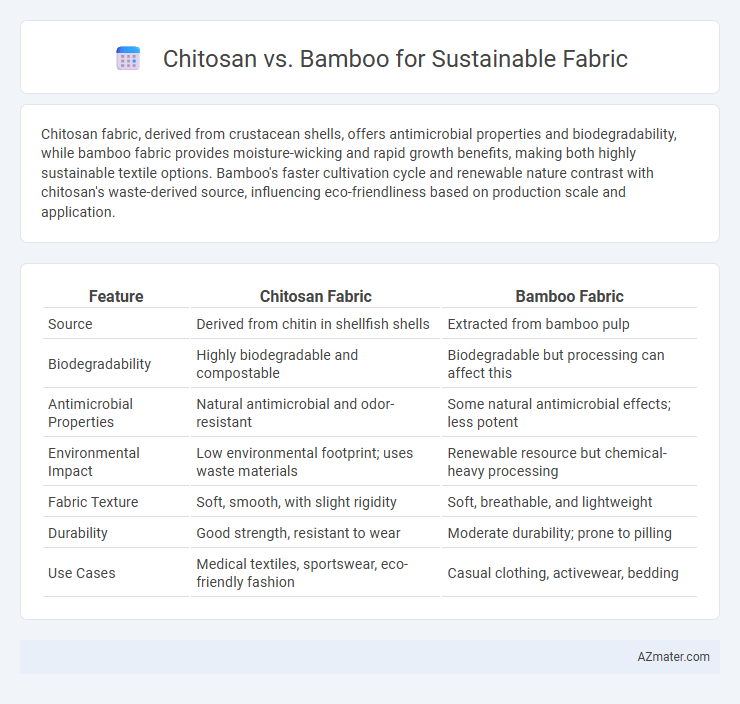Chitosan fabric, derived from crustacean shells, offers antimicrobial properties and biodegradability, while bamboo fabric provides moisture-wicking and rapid growth benefits, making both highly sustainable textile options. Bamboo's faster cultivation cycle and renewable nature contrast with chitosan's waste-derived source, influencing eco-friendliness based on production scale and application.
Table of Comparison
| Feature | Chitosan Fabric | Bamboo Fabric |
|---|---|---|
| Source | Derived from chitin in shellfish shells | Extracted from bamboo pulp |
| Biodegradability | Highly biodegradable and compostable | Biodegradable but processing can affect this |
| Antimicrobial Properties | Natural antimicrobial and odor-resistant | Some natural antimicrobial effects; less potent |
| Environmental Impact | Low environmental footprint; uses waste materials | Renewable resource but chemical-heavy processing |
| Fabric Texture | Soft, smooth, with slight rigidity | Soft, breathable, and lightweight |
| Durability | Good strength, resistant to wear | Moderate durability; prone to pilling |
| Use Cases | Medical textiles, sportswear, eco-friendly fashion | Casual clothing, activewear, bedding |
Introduction to Sustainable Fabrics
Sustainable fabrics like chitosan and bamboo offer eco-friendly alternatives to conventional textiles by utilizing renewable resources and minimizing environmental impact. Chitosan, derived from crustacean shells, provides natural antimicrobial properties and biodegradability, while bamboo fabric is praised for its rapid growth, low water usage, and soft, breathable texture. Both materials support sustainability goals by reducing chemical use, promoting biodegradability, and improving resource efficiency in the textile industry.
What is Chitosan Fabric?
Chitosan fabric is a sustainable textile made from chitosan, a natural biopolymer derived from the shells of crustaceans like shrimp and crabs, known for its biodegradability and antimicrobial properties. This innovative fabric offers excellent moisture absorption, breathability, and resistance to bacteria, making it ideal for eco-friendly clothing and medical textiles. Compared to bamboo fabric, chitosan provides unique functional benefits while supporting waste valorization from marine resources.
What is Bamboo Fabric?
Bamboo fabric is a sustainable textile derived from the pulp of bamboo grass, known for its natural antibacterial properties and high breathability. It undergoes a mechanical or chemical process to transform bamboo fibers into soft, durable fabric suitable for clothing and home textiles. This eco-friendly material offers biodegradable benefits and requires fewer pesticides compared to traditional cotton farming, making it a popular choice in sustainable fashion.
Production Processes: Chitosan vs Bamboo
Chitosan fabric production involves extracting chitin from crustacean shells through deacetylation, followed by chemical treatment to create a biodegradable textile with antimicrobial properties. Bamboo fabric is produced by mechanically crushing bamboo culms and chemically processing them into viscose or lyocell fibers, offering renewable, fast-growing raw material advantages but requiring significant chemical treatment. Both processes emphasize sustainability, yet chitosan's bio-waste origin contrasts with bamboo's rapid renewability and resource-intensive fiber extraction.
Environmental Impact Comparison
Chitosan fabric, derived from crustacean shells, offers biodegradability and antimicrobial properties, significantly reducing chemical usage in textile production compared to Bamboo fabric, which requires intensive water and chemical processing for fiber extraction. Bamboo farming supports rapid growth and carbon sequestration, yet the viscose process often involves harmful solvents impacting ecosystems. Both materials present sustainable advantages, but chitosan fibers demonstrate lower environmental toxicity and waste footprint in comparison to conventional bamboo fabric production methods.
Biodegradability and End-of-Life
Chitosan fabric, derived from crustacean shells, offers superior biodegradability, breaking down naturally in soil within weeks without harmful residues, unlike many synthetic alternatives. Bamboo fabric, made from bamboo cellulose, is also biodegradable but often undergoes chemical processing that can reduce its environmental benefits and delay decomposition. Both materials provide sustainable options, yet chitosan's naturally antimicrobial properties and rapid end-of-life degradation make it particularly advantageous for eco-friendly textile solutions.
Performance and Durability
Chitosan-based fabrics exhibit excellent antimicrobial properties and biodegradability, making them highly sustainable with enhanced moisture-wicking performance and resistance to bacterial growth. Bamboo fabric offers superior softness, breathability, and natural UV protection, combined with impressive tensile strength and durability, ensuring long-lasting wear. Both materials deliver eco-friendly benefits, but chitosan's unique antimicrobial durability contrasts with bamboo's robust physical resilience in sustainable textile applications.
Applications in the Textile Industry
Chitosan and bamboo fibers both offer sustainable advantages in textile applications, with chitosan providing antimicrobial properties that enhance fabric hygiene and durability, making it ideal for activewear and medical textiles. Bamboo fibers deliver natural breathability and moisture-wicking capabilities, widely used in eco-friendly clothing, home textiles, and bedding products. Integration of chitosan coatings with bamboo fabrics can further improve odor control and biodegradability, promoting innovative sustainable solutions in the textile industry.
Market Trends and Consumer Demand
Chitosan and bamboo fabrics are gaining momentum in the sustainable textile market due to their eco-friendly properties and biodegradability. Bamboo fabric benefits from rapid growth rates and natural antibacterial qualities, attracting consumer demand for breathable, hypoallergenic clothing, while chitosan's antimicrobial and moisture-wicking features are favored in high-performance and medical textiles. Market trends indicate increasing investment in chitosan-based textiles driven by innovation in bio-polymers, whereas bamboo fabric maintains strong appeal through its natural origin and affordability, fueling growth in eco-conscious fashion segments.
Future Prospects for Chitosan and Bamboo Fabrics
Chitosan fabrics exhibit significant potential due to their biodegradability, antimicrobial properties, and ability to enhance moisture management, positioning them as ideal candidates for sustainable textile innovation. Bamboo fabric, derived from a rapidly renewable resource, offers natural antibacterial qualities and impressive breathability, supporting eco-friendly fashion trends and reducing reliance on synthetic fibers. Future development in processing technologies and scaling production are expected to advance both chitosan and bamboo fabrics, contributing to a circular economy and meeting increasing consumer demand for green, high-performance textiles.

Infographic: Chitosan vs Bamboo for Sustainable Fabric
 azmater.com
azmater.com